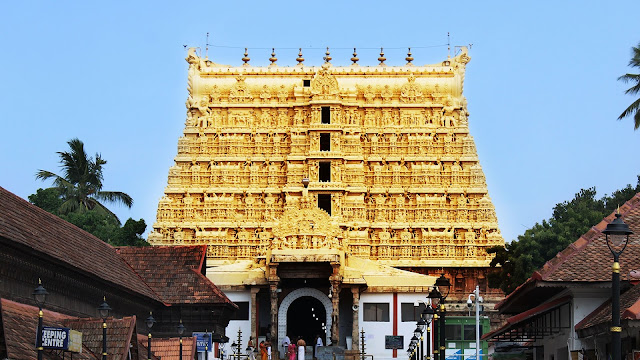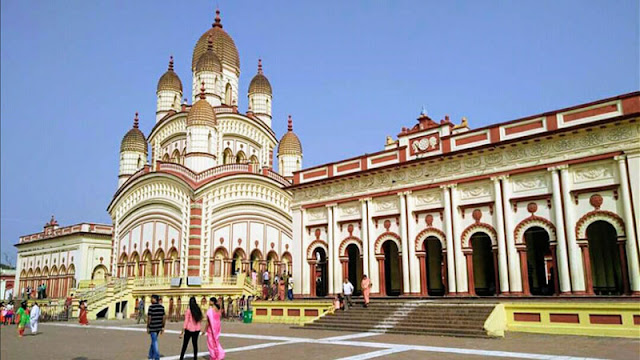Most 20 mysterious temples in India.
1. Sri Ranganathaswamy Temple, Tamil Nadu
2. Brihadeeswarar Temple, Tamil Nadu
3. Meenakshi Temple, Tamil Nadu
4. Virupaksha Temple, Karnataka
5. Kapaleeswarar Temple, Tamil Nadu
6. Nataraja Temple, Tamil Nadu
7. Padmanabhaswamy Temple, Kerala
--The Padmanabhaswamy Temple is a Hindu temple located in Thiruvananthapuram, Kerala, India. The temple is dedicated to Lord Vishnu and is considered one of the 108 Divya Desams, the sacred abodes of Lord Vishnu. According to Hindu legend, the temple was established by Lord Brahma and was later renovated by King Marthanda Varma in the 18th century. The temple is known for its wealth, with secret chambers discovered in 2011 containing valuable items including gold, jewels, and precious stones. The exact origin of the temple is unknown, but it is believed to be over a thousand years old.
8. Jambukeswarar Temple, Tamil Nadu
9. Srisailam Mallikarjuna Temple, Andhra
Pradesh
--Srisailam Mallikarjuna Temple is a Hindu temple located in Srisailam, Andhra Pradesh, India. It is dedicated to Lord Shiva and is one of the twelve Jyotirlinga shrines, where Lord Shiva is worshipped in the form of a lingam. The temple has a history dating back to the ancient times and is mentioned in various Hindu scriptures like the Puranas and the Mahabharata. The current structure of the temple is believed to have been built during the Chalukya dynasty, around the 7th century AD. Over the centuries, the temple has undergone several renovations and additions, with the Vijayanagara kings being major patrons of the temple. The temple continues to be an important pilgrimage site for Hindus and attracts thousands of devotees every year.
10. Shirdi Sai Baba Temple, Maharashtra
--The Shirdi Sai Baba Temple is located in the town of Shirdi in Maharashtra, India. The temple is dedicated to the 19th century Indian spiritual leader, Sai Baba of Shirdi, who is revered by millions of devotees as a saint, fakir, and satguru. The temple was built over the Samadhi (tomb) of Sai Baba, and has since become one of the most visited pilgrimage sites in India. The temple was originally a small structure, but due to the growing popularity of Sai Baba, it was later expanded and renovated. The temple complex today includes several shrines, halls, and other buildings, and is visited by millions of devotees every year.
11. Bhimashankar Temple, Maharashtra
-Bhimashankar Temple is a Hindu shrine located in the village of Bhorgiri near Pune, Maharashtra, India. It is one of the twelve Jyotirlinga shrines dedicated to Lord Shiva and is considered to be one of the holiest shrines in Hinduism. The temple has a long history, with references to it being found in ancient Hindu scriptures such as the Puranas. According to legend, the temple was built by the Pandavas during the Mahabharata era and was later rebuilt by the Maratha ruler Chhatrapati Shivaji in the 17th century. The temple attracts large numbers of pilgrims and tourists every year, particularly during the festival of Mahashivaratri.
12. Somnath Temple, Gujarat
--The Somnath Temple in Gujarat, India, is one of the 12 jyotirlingas, considered to be the most sacred shrines dedicated to the Hindu god, Lord Shiva. The temple has a long history, dating back to ancient times and has been destroyed and reconstructed several times over the centuries.
The first temple was built by the moon god Soma, according to Hindu mythology. It was later destroyed and reconstructed by the Yadava kings and then by King Bhimdev of the Solanki dynasty in the 10th century. The temple reached its height of glory during the rule of the Solanki dynasty, but was plundered several times by invaders, including the famous invasion by the Turkic ruler, Sultan Mahmud of Ghazni in the 11th century.
In the 16th century, the temple was reconstructed by the Maratha king, Shivaji and later by the great Maratha leader, Sardar Vallabhbhai Patel after India's independence in 1947. The present-day Somnath Temple is a symbol of national unity and pride for India and attracts thousands of pilgrims and tourists every year.
13. Mahakaleshwar Temple, Madhya Pradesh
--Mahakaleshwar Temple is a Hindu temple located in the city of Ujjain in Madhya Pradesh, India. The temple is dedicated to Lord Shiva and is one of the twelve Jyotirlingas, shrines considered to be particularly sacred in Hinduism. According to Hindu mythology, the temple was established in ancient times and has been mentioned in various Hindu scriptures such as the Skanda Purana. The temple has been destroyed and rebuilt several times over the centuries, with the present structure dating back to the 18th century. The Mahakaleshwar Temple attracts thousands of pilgrims every year and is one of the major tourist attractions in Madhya Pradesh.
14. Varaha Temple, Uttar Pradesh
--The Varaha Temple is located in the city of Varanasi, Uttar Pradesh, India. It is dedicated to the Hindu god Vishnu and is one of the oldest temples in the city, believed to have been built during the Gupta Empire (4th to 6th century CE). The temple features a unique architectural style, combining elements of North Indian Nagara and South Indian Dravidian styles. The temple is considered an important pilgrimage site for Hindu devotees, who come to offer prayers and participate in religious ceremonies. The temple has undergone several renovations and additions over the centuries and remains an active place of worship to this day.
15. Kashi Vishwanath Temple, Uttar Pradesh
--The Kashi Vishwanath Temple is a Hindu temple dedicated to Lord Shiva, located in the city of Varanasi (also known as Kashi) in Uttar Pradesh, India. It is one of the twelve Jyotirlinga temples, where Lord Shiva is worshiped in the form of a lingam (a symbol of the divine phallus). The temple has a long history, with the first temple believed to have been built by the Hindu king, Hastinapura, in the late 1700s BC. Over the centuries, the temple has been destroyed and rebuilt several times by different rulers, including the Mughal emperor Aurangzeb, who demolished the temple in 1669 AD and built a mosque on its site. The temple was eventually restored in the late 18th century by Maratha ruler, Ahilyabai Holkar, and has since been an important place of pilgrimage for Hindus.
16. Hanuman Garhi, Uttar Pradesh
--Hanuman Garhi is a Hindu temple located in Ayodhya, Uttar Pradesh, India. The temple is dedicated to Lord Hanuman and is considered one of the most sacred shrines in the city. It is said to be built by the Hindu warrior-king, Raja Dashratha (father of Lord Rama), over 3,000 years ago. According to legend, Hanuman Garhi served as the residence of Lord Hanuman during the construction of the Ram Temple. The temple features a large statue of Lord Hanuman and attracts thousands of devotees every year. It is considered an important site of pilgrimage for devotees of Lord Rama and Lord Hanuman.
17. Konark Sun Temple, Odisha
The Konark Sun Temple, located in the coastal town of Konark in the state of Odisha, India, was built in the 13th century by King Narasimhadeva I of the Eastern Ganga dynasty. It is dedicated to the Hindu god Surya (the sun) and is renowned for its grand architecture and intricate carvings. The temple complex features a massive chariot-shaped structure, with 12 pairs of wheels, pulled by seven horses and driven by the sun god. The temple was built as a symbol of the king's victory over the Muslim invaders and was considered one of the grandest monuments of its time. The temple was declared a UNESCO World Heritage Site in 1984. Unfortunately, over the centuries, much of the temple has been damaged and destroyed, but its legacy remains as a symbol of India's rich cultural heritage.
18. Jagannath Temple, Odisha
--The Jagannath Temple in Puri, Odisha is a famous Hindu temple dedicated to Lord Jagannath, a form of Lord Vishnu. It is one of the Char Dham pilgrimage sites and one of the oldest shrines in India. The origins of the temple date back to the 11th century and its construction is believed to have been initiated by King Anantavarman Chodaganga Deva. The temple has undergone several renovations and additions over the centuries, and the present structure is a result of the work carried out by the Ganga dynasty in the 12th century and later by the Eastern Ganga dynasty in the 13th century. The temple is known for its annual Rath Yatra festival, during which the deity's idols are taken out in grand processions on chariots.
19. Dakshineswar Kali Temple, West Bengal
--The Dakshineswar Kali Temple is a Hindu temple located in Dakshineswar, near Kolkata, West Bengal, India. It was built in 1855 by Rani Rashmoni, a philanthropist and devout Hindu, as a symbol of her devotion to the goddess Kali. The temple complex, which covers an area of more than 25 acres, includes the main temple, 12 smaller shrines dedicated to Lord Shiva, and a large pond known as Radha-Kanta. The temple is famous for its association with the 19th-century Hindu mystic and yogi Sri Ramakrishna, who lived and taught near the temple for many years and had a deep spiritual connection to the goddess Kali. Today, the temple is a major pilgrimage site and a popular tourist destination in West Bengal, attracting hundreds of thousands of visitors each year.
20. Pashupatinath Temple, Nepal














.jpg)





Comments
Post a Comment